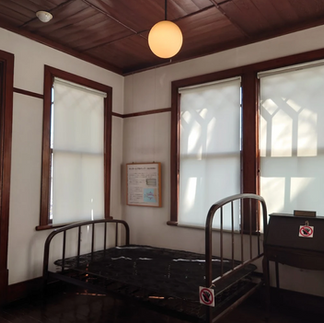Zoshigaya Old Missionary Museum (The Old McCaleb House)
- Kristine Ohkubo

- Oct 24
- 3 min read

Finding old Western-style houses in Japan is not uncommon, and these architectural gems offer a fascinating glimpse into the country's historical interactions with the West. Among the most notable examples are the Glover Residence in Nagasaki, the Yodoko Guest House in Ashiya, and the elegant mansions located in Kobe's Kitano-cho district, to name just a few. These structures, often characterized by their distinctive Western architectural features, were primarily constructed during the Meiji period (1868–1912) and the Taisho period (1912–1926). Many of these homes can be found in port cities and suburban areas, reflecting the significant cultural and economic exchanges that took place during this transformative era. Known as ijinkan (foreigners' houses), these residences showcase a variety of European architectural influences, from Victorian to Gothic, which were adapted to fit the Japanese context.

The signing of the Convention of Kanagawa in 1854 marked a pivotal moment in Japan's history, as it effectively ended the nation's two centuries of self-imposed isolation. This agreement allowed for the establishment of diplomatic relations and trade with Western nations, leading the Japanese government to invite foreigners to enter the country. These foreign individuals, referred to as yatoi or hired foreign experts, played a crucial role in introducing Western knowledge, technology, and cultural practices to Japan. As a result, foreign communities began to flourish in designated treaty port concessions, including Shimoda, Hakodate, Yokohama, Kobe, Nagasaki, Osaka, and Niigata. These settlements, governed by extraterritoriality, transformed into vibrant centers for foreign trade, diplomacy, and cultural exchange, contributing to the modernization of Japan.


With the influx of foreigners into Japan came a wave of missionaries eager to spread Christianity and provide education. One notable figure among these missionaries was John Moody McCaleb (1861–1953). He and his wife Della embarked on their journey to Japan in 1892, driven by a strong desire to contribute to the spiritual and educational development of the local population. In 1907, McCaleb constructed a two-story wooden Western-style residence on a hill in Zoshigaya, one of Tokyo's 23 special wards. He imported the wood and other materials from his hometown in Tennessee, ensuring that his house reflected the architectural style of mid- to late-19th century suburban houses in the United States. The design features a "T" shape with three rooms on each floor, and fireplaces installed back to back in all the rooms, which were all connected to a single chimney within the wall, creating a sense of simplicity and cleanliness throughout the living space. The windows in the indoor porch on the south side were strategically placed to allow sunlight to stream in, enhancing the warmth and inviting atmosphere of the home.
This residence served not only as McCaleb's home but also as a religious center where he could engage with the local community until he was repatriated in 1941 due to the rising tensions of World War II. He was known for his generosity, making his garden available to neighboring children as a playground, thus fostering a sense of community among the residents. McCaleb had a particular interest in the education of young children, and it is no coincidence that today, a kindergarten exists right next door.
In recent years, the Zoshigaya Missionary Museum has become a focal point for preserving this historical legacy. When the building was threatened with demolition, local residents rallied together to campaign for its preservation, demonstrating the community's deep appreciation for its historical significance. The structure was purchased by Toshima city in 1982, and after extensive repair and restoration work, the museum opened to the public in 1989. In recognition of its cultural importance, the building was registered as a tangible cultural asset of the ward in 1987. Inside the museum, visitors can explore a collection of photographs, McCaleb's bed, desk, and other period furniture, all of which provide a fascinating insight into the life and work of this dedicated missionary and the broader historical context of Western influence in Japan.



















Comments